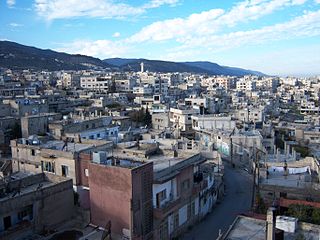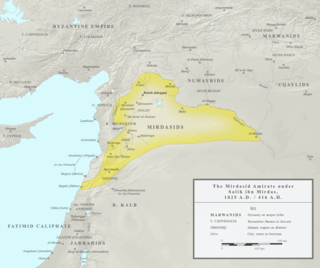
The Ayyubid dynasty, also known as the Ayyubid Sultanate, was the founding dynasty of the medieval Sultanate of Egypt established by Saladin in 1171, following his abolition of the Fatimid Caliphate of Egypt. A Sunni Muslim of Kurdish origin, Saladin had originally served the Zengid ruler Nur ad-Din, leading Nur ad-Din's army in battle against the Crusaders in Fatimid Egypt, where he was made Vizier. Following Nur ad-Din's death, Saladin was proclaimed as the first Sultan of Egypt by the Abbasid Caliphate, and rapidly expanded the new sultanate beyond the frontiers of Egypt to encompass most of the Levant, in addition to Hijaz, Yemen, northern Nubia, Tarabulus, Cyrenaica, southern Anatolia, and northern Iraq, the homeland of his Kurdish family. By virtue of his sultanate including Hijaz, the location of the Islamic holy cities of Mecca and Medina, he was the first ruler to be hailed as the Custodian of the Two Holy Mosques, a title that would be held by all subsequent sultans of Egypt until the Ottoman conquest of 1517. Saladin's military campaigns in the first decade of his rule, aimed at uniting the various Arab and Muslim states in the region against the Crusaders, set the general borders and sphere of influence of the sultanate of Egypt for the almost three and a half centuries of its existence. Most of the Crusader states, including the Kingdom of Jerusalem, fell to Saladin after his victory at the Battle of Hattin in 1187. However, the Crusaders reconquered the coast of Palestine in the 1190s.

The Zengid or Zangid dynasty, also referred to as the Atabegate of Mosul, Aleppo and Damascus, or the Zengid State was initially an Atabegate of the Seljuk Empire created in 1127. It formed a Turkoman dynasty of Sunni Muslim faith, which ruled parts of the Levant and Upper Mesopotamia, and eventually seized control of Egypt in 1169. In 1174 the Zengid state extended from Tripoli to Hamadan and from Yemen to Sivas. Imad ad-Din Zengi was the first ruler of the dynasty.
Majd ad-Dīn Usāma ibn Murshid ibn ʿAlī ibn Munqidh al-Kināni al-Kalbī or Ibn Munqidh was a medieval Arab Muslim poet, author, faris (knight), and diplomat from the Banu Munqidh dynasty of Shaizar in northern Syria. His life coincided with the rise of several medieval Muslim dynasties, the arrival of the First Crusade, and the establishment of the crusader states.

Masyaf is a city in northwestern Syria. It is the center of the Masyaf District in the Hama Governorate. As of 2004, Masyaf had a religiously diverse population of approximately 22,000 Ismailis, Alawites and Christians. The city is well known for its large medieval castle, particularly its role as the headquarters of the Nizari Ismailis and their elite Assassins unit.

Shaizar or Shayzar is a town in northern Syria, administratively part of the Hama Governorate, located northwest of Hama. Nearby localities include, Mahardah, Tremseh, Kafr Hud, Khunayzir and Halfaya. According to the Syria Central Bureau of Statistics (CBS), Shaizar had a population of 5,953 in the 2004 census.

Sahyun Castle, also known as the Castle of Saladin, is a medieval castle in northwestern Syria. It is located 7 km east of Al-Haffah town and 30 km east of the city of Latakia, in high mountainous terrain on a ridge between two deep ravines and surrounded by forest, the site has been fortified since at least the mid 10th century. In 975 the Byzantine Emperor John I Tzimiskes captured the site and it remained under Byzantine control until around 1108. Early in the 12th century the Franks assumed control of the site and it was part of the newly formed Crusader state of the Principality of Antioch. The Crusaders undertook an extensive building programme, giving the castle much of its current appearance. In 1188 it fell to the forces of Saladin after a three-day siege. The castle was again besieged in 1287, this time both defender and belligerent were Mamluks. In 2006, the castles of Qal'at Salah El-Din and Krak des Chevaliers were recognised as a World Heritage Site by UNESCO. The site is owned by the Syrian government.
Abu Ulwan Thimal ibn Salih ibn Mirdas, also known by his laqabMu'izz al-Dawla, was the Mirdasid emir of Aleppo jointly with his elder brother Shibl al-Dawla Nasr in 1029–1030 and then solely in 1042–1057 and 1061–1062.

Abu Ali Salih ibn Mirdas, also known by his laqabAsad al-Dawla, was the founder of the Mirdasid dynasty and emir of Aleppo from 1025 until his death in May 1029. At its peak, his emirate (principality) encompassed much of the western Jazira, northern Syria and several central Syrian towns. With occasional interruption, Salih's descendants ruled Aleppo for the next five decades.

The Mirdasid dynasty, also called the Banu Mirdas, was an Arab Shia Muslim dynasty which ruled an Aleppo-based emirate in northern Syria and the western Jazira more or less continuously from 1024 until 1080.
Ma'arrat Misrin is a small city in northwestern Syria, administratively part of Idlib Governorate. Ma'arrat Misrin lies an elevation of 338 metres (1,109 ft). It is located 50 kilometers southwest of Aleppo and 40 kilometers north of Ma'arrat al-Numan and 12 kilometers from Sarmin. Nearby localities include Kafr Yahmul to the north, Zardana and Maarrat al-Ikhwan to the northeast, Taftanaz to the east, Ta'um, Binnish, al-Fu'ah and Kafriya to the southeast, Idlib to the south, and Hafasraja to the southwest.
An-Nasir Yusuf, fully al-Malik al-Nasir Salah al-Din Yusuf ibn al-Aziz ibn al-Zahir ibn Salah al-Din Yusuf ibn Ayyub ibn Shazy, was the Ayyubid Kurdish Emir of Syria from his seat in Aleppo (1236–1260), and the Sultan of the Ayyubid Empire from 1250 until the sack of Aleppo by the Mongols in 1260.
Al-Muzaffar Taqi al-Din Umar was the Ayyubid prince of Hama from 1179 to 1191 and a general of Saladin. He was the son of Saladin's brother Nur ad-Din Shahanshah, and brother of Farrukh Shah of Baalbek.

The siege of Shaizar took place from April 28 to May 21, 1138. The allied forces of the Byzantine Empire, Principality of Antioch and County of Edessa invaded Muslim Syria. Having been repulsed from their main objective, the city of Aleppo, the combined Christian armies took a number of fortified settlements by assault and finally besieged Shaizar, the capital of the Munqidhite Emirate. The siege captured the city, but failed to take the citadel; it resulted in the Emir of Shaizar paying an indemnity and becoming the vassal of the Byzantine emperor. The forces of Zengi, the greatest Muslim prince of the region, skirmished with the allied army but it was too strong for them to risk battle. The campaign underlined the limited nature of Byzantine suzerainty over the northern Crusader states and the lack of common purpose between the Latin princes and the Byzantine emperor.
Baarin is a village in northern Syria, administratively part of the Hama Governorate, located in Homs Gap roughly 38 kilometers (24 mi) southwest of Hama. Nearby localities include Taunah and Awj to the south, Aqrab and Houla to the southeast, Nisaf, Ayn Halaqim and Wadi al-Uyun to the west, Masyaf, Deir Mama and Mahrusah to the north, and Deir al-Fardis and al-Rastan to the east. According to the Syria Central Bureau of Statistics (CBS), Baarin had a population of 5,559 in the 2004 census. Baarin is also the largest locality in the Awj nahiyah ("subdistrict") which comprises thirteen villages with a population of 33,344. The village's inhabitants are predominantly Alawites.

Abu Qubays is a former medieval castle and currently an inhabited village in northwestern Syria, administratively part of the Hama Governorate, located northwest of Hama. It is situated in the al-Ghab plain, west of the Orontes River. Nearby localities include Daliyah 21 kilometers to the west, al-Laqbah to the south, Deir Shamil to the southeast, Tell Salhab to the northeast and Nahr al-Bared further northeast. According to the Syria Central Bureau of Statistics (CBS), Abu Qubays had a population of 758 in the 2004 census. Its inhabitants are predominantly Alawites.
The Banu Kilab was an Arab tribe in the western Najd where they controlled the horse-breeding pastures of Dariyya from the mid-6th century until at least the mid-9th century. The tribe was divided into ten branches, the most prominent being the Ja'far, Abu Bakr, Amr, Dibab and Abd Allah. The Ja'far led the Kilab and its parent tribe of Banu Amir, and, at times, the larger Hawazin tribal confederation from the time of the Kilab's entry into the historical record, c. 550, until the advent of Islam, c. 630, except for two occasions when the larger Abu Bakr was at the helm. Under the Ja'far's leadership the Kilab defeated rival tribes and the Lakhmid kings and eventually became guards of the Lakhmid caravans to the annual fair in the Hejaz. The killing of a Ja'far chief as he escorted one such caravan led to the Fijar War between the Hawazin and the Quraysh of Mecca.

Al-Rahba, also known as Qal'at al-Rahba, which translates as the "Citadel of al-Rahba", is a medieval Arab fortress on the west bank of the Euphrates River, adjacent to the city of Mayadin in Syria. Situated atop a mound with an elevation of 244 meters (801 ft), al-Rahba oversees the Syrian Desert steppe. It has been described as "a fortress within a fortress"; it consists of an inner keep measuring 60 by 30 meters, protected by an enclosure measuring 270 by 95 meters. Al-Rahba is largely in ruins today as a result of wind erosion.
The amir al-ʿarab was the commander or leader of the Bedouin tribes in Syria under successive medieval Muslim states. The title was used as early as the 11th century to refer to Salih ibn Mirdas, but was formalized as a state institution by the Ayyubid Sultanate and strengthened by the latter's Mamluk successors. The office was preserved under the early Ottomans, at least ceremonially, but its importance had declined by then. The jurisdiction of the amir al-ʿarab was generally limited to central and northern Syria, and its holder often held iqtaʿat (fiefs) in the Syrian steppe, which formed the imarat al-ʿarab. The imarat al-ʿarab was created both to co-opt the often rebellious Bedouin tribes of Syria and to enlist their support as auxiliary troops. Under the Mamluks, some of the principal duties of the amir al-ʿarab were guarding the desert frontier against the Mongol Ilkhanate in Iraq and Anatolia, ensuring Bedouin loyalty to the state, gathering intelligence on enemy forces, protecting infrastructure, villages and travelers from raids and providing horses and camels to the sultan. In return, the amir al-ʿarab was given iqtaʿat, an annual salary, official titles and honorary robes.
The Banu Munqidh, also referred to as the Munqidhites, were an Arab family that ruled an emirate in the Orontes Valley in northern Syria from the mid-11th century until the family's demise in an earthquake in 1157. The emirate was initially based in Kafartab before the Banu Munqidh took over the fortress of Shayzar in 1081 and made it their headquarters for the remainder of their rule. The capture of Shayzar was the culmination of a long, drawn-out process beginning with the Banu Munqidh's nominal assignment to the land by the Mirdasid emir of Aleppo in 1025, and accelerating with the weakened grip of Byzantine rule in northern Syria in the 1070s.
Abūʾl-Faḍāʾil Sābiq ibn Mahmūd was the Mirdasid emir of Aleppo from 1076 to 1080.










